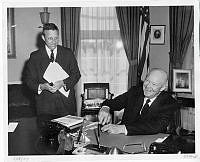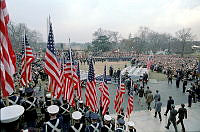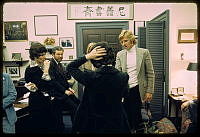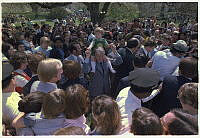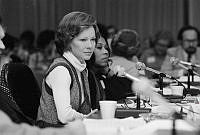John James Audubon and the American Presidency
Copyright © Fall 2013 White House Historical Association. All rights reserved under international copyright conventions. No part of this article may be reproduced or utilized in any form or by any means, electronic or mechanical, including photocopying, recording, or by any information storage and retrieval system, without permission in writing from the publisher. Requests for reprint permissions should be addressed to books@whha.org
Look at the John Syme portrait of John James Audubon that is now included in the White House art collection, and you get a quick idea of Audubon’s gifts as a showman. Today, Audubon (1785–1851) endures in popular memory as the world’s most famous artist of birds. But when he agreed to pose for Syme in 1826, Audubon was still struggling to establish his name as an innovative painter of American wildlife. Audubon’s ambition took him through England to Edinburgh, Scotland, a great center of science and industry, where the artist had traveled to secure critical support for his landmark Birds of America project.1 That’s where Audubon encountered Syme, a Scottish artist, who asked to paint Audubon’s picture in oil.2
William Home Lizars, who had joined Audubon’s Birds of America project as an engraver, encouraged Audubon to grant Syme’s request, figuring that engraved copies of the portrait would be a great way to raise Audubon’s profile.3 As a publicity tool, Syme’s Audubon portrait has obvious interest. Dressed in wolfskin coat and bearing a gun across his chest, Audubon seems the quintessential woodsman—a figure with special appeal in an Old World culture that often viewed the American frontier as glamorously exotic. Like Benjamin Franklin, who had wooed the salons of Paris a generation earlier in his fur cap, Audubon had created a sensation in England with attire that one observer described as “not made by a West end but a Far West tailor.”4
Audubon, however, had reservations about Syme’s handiwork. He found the two-hour sessions in which he posed for Syme tedious, and when the job was finished, he did not like Syme’s result.5 Audubon was especially critical of how Syme had depicted his eyes, concluding that “to me [they] are more those of an enraged eagle than mine.”6 But Audubon was pleased enough with the picture that he hung it at the entrance of his subsequent exhibition.7
For Audubon, the strain of standing still for a portrait must have seemed quite a departure, as in his own artwork he rarely worked with live subjects. Most of Audubon’s strikingly detailed pictures were made from birds that Audubon shot in the wilds of North America. To make his lifeless specimens seem more dynamic, he arranged them on a specially devised board, using pins to hold them in lifelike positions.8 His technique, which created the stunning illusion of a bird at work or play in its native flora and fauna, set Audubon apart from his contemporary artists, who often published books in which birds were lined up without context against blank backgrounds, like so many butterflies pinned to velvet. Ironically, Audubon had honed his skills at drawing lifeless birds by working on human subjects. In the early nineteenth century, before photography made family snapshots a fixture of household life, bereaved families would secure a keepsake image of a dying or recently departed loved one by commissioning a deathbed portrait. Audubon helped support his fledgling painting career by working as a deathbed artist, and he proved so good at it that a grieving clergyman had his dead child disinterred for an Audubon commission.9
While Audubon found Syme’s portrait of him to be somewhat bird-like, Audubon’s pictures of birds can brim with a sense of personality that, conversely, makes them seem almost human. In one of two Audubon bird prints in the White House collection, a pelican gazes back at the viewer with the confident posture of a president on a postage stamp. In a companion Audubon picture from the collection, male and female Iceland falcons spar as briskly as an old married couple. Both Audubon pictures now hang in the White House living quarters.
In agreeing to sit for Syme’s painting, Audubon had also cultivated an important ally. Shortly after Syme completed the picture, Audubon asked the Scotsman if he would recommend him for membership in the Scottish Academy of Fine Arts—one step in Audubon’s ambitious campaign to advance his reputation and get subscribers to his Birds of America series. Syme quickly obliged, and Audubon was admitted.10 Audubon’s relationship with Syme underscores the bird artist’s political skill, an attribute that would help him gain significant support from many people of influence, including William Henry Harrison before he became president and Andrew Jackson while he occupied the White House.
Throughout his career, Audubon’s work would be significantly shaped by presidential policies, and his work, in turn, would help shape the thinking of at least one American president. Born in what is now Haiti and raised mostly in France, Audubon came to America to seek his fortune in 1803, the same year that Thomas Jefferson authorized the Louisiana Purchase. The timing would prove eventful, dramatically expanding the American frontier that Audubon used as his ornithological studio. Audubon first dabbled in bird art part-time, achieving affluence through his principal livelihood as a merchant and mill owner in the Kentucky pioneer town of Henderson. But after his business was bankrupted in the Panic of 1819, Audubon decided to become a fulltime artist, intent on compiling the most comprehensive pictorial survey of birds ever produced, The Birds of America. To smooth his way on his wilderness travels, Audubon sought letters of introduction from political figures, including Henry Clay, who would later vie unsuccessfully for the presidency three times, and Harrison, a future president. Such letters could be helpful in dealing with government matters, raising money, or making business arrangements.
As the Audubon biographer Shirley Streshinsky has pointed out, Audubon was adept at securing letters of introduction—“those magic keys to the doors (and, he hoped, the purses) of the American public.”11 In 1829, after returning to America from England, where he had been advancing plans for The Birds of America, Audubon “had but to flash a letter from President Andrew Jackson for the collector of the customhouse to wave him through without paying any duty,” Streshinsky reports.12
Although Audubon courted the favors of numerous political leaders, his connection with Jackson was particularly memorable. Audubon and his wife, Lucy, had briefly met Jackson during a visit to Washington, D.C., in 1830.13 By 1836, with his fame now growing and Jackson near the end of his second term, Audubon had dinner with the president at the White House. The visit also connected Audubon with Jackson’s nephew-in-law and a fellow artist, Ralph E. W. Earl, who was hard at work in his studio upstairs on one of his portraits of Jackson. During the visit, Earl showed Audubon the celebrated Gilbert Stuart portrait of George Washington that Dolley Madison had rescued during the War of 1812.14
The White House dinner menu included a turkey shot in nearby woods—a nice if perhaps unintentional nod to Audubon, who had a particular fondness for the bird that Franklin had once promoted over the bald eagle as the national symbol.15 Audubon began The Birds of America with a picture of a wild turkey cock.
Over dinner, Jackson offered Audubon the use of a government gunboat, the Campbell, for his explorations, and Audubon eventually boarded the Campbell in New Orleans to scout birds along the Gulf Coast from the Mississippi River to Galveston. His journey also included a trip to Houston, where he met Sam Houston, president of the fledgling Republic of Texas.16
Years before their White House dinner, Audubon’s and Jackson’s paths had crossed in one of the more interesting side chapters of American art history. While visiting New York City in 1824, Audubon met his friend and fellow painter John Vanderlyn, who was hard at work on a painting of Jackson. Vanderlyn noticed that Audubon and Jackson had similar builds, so he asked Audubon to serve as Jackson’s body double for the portrait, posing Audubon in full military uniform.17 To acknowledge Audubon’s contribution, Vanderlyn placed Audubon’s face on a soldier in the background of the painting.18
In subsequent years, Audubon would have a more profound influence on presidential history. As a young amateur naturalist, Theodore Roosevelt was trained by one of Audubon’s student taxidermists.19 In reading Audubon’s prose and studying his pictures, Roosevelt became worried about the extinction of species, and Audubon’s work helped inspire him, as president, to advance various conservation initiatives, including the preservation of vast expanses of wilderness areas.20
Syme’s portrait of Audubon, donated to the White House collection in 1962, is an abiding reminder of a naturalist whose legacy continues to resonate across America and the world.

John James Audubon by John Syme, 1826, oil on canvas.

Audubon’s Brown Pelican and Iceland Falcons hang in the White House, 2009.

Brown Pelican by John James Audubon.
Library of Congress
Iceland Falcons by John James Audubon.

This drawer pulled from the collection of John James Audubon specimens in the National Museum of Natural History contains (left to right) Glossy Ibis, Roseate Spoonbill, two Reddish Egrets, and a Greater White Front Goose.

This drawer pulled from the collection of John James Audubon specimens in the National Museum of Natural History contains (left to right) Glossy Ibis, Roseate Spoonbill, two Reddish Egrets, and a Greater White Front Goose.

Spencer Baird’s original handwritten tags and the subsequent Smithsonian accession labels identify each Audubon specimen. This Peregrine Falcon is identified as an adult female, and the tag also references Plate XVI , which is Audubon’s Great Footed Hawk—Falco Peregrinus (Peregrine Falcon) Devouring Gadwall and Green-Winged Teal.

These examples of small birds collected by Audubon and now in the collections of the National Museum of Natural History include Palm Warbler, Pine Warbler, Western Kingbird, and Spotted Towhee. More than 160 years after Audubon’s death, these specimens remain brightly colored and well preserved.

General Andrew Jackson by John Vanderlyn, c. 1824. Audubon assisted Vanderlyn by posing as Jackson’s body double for the portrait. In return, Vanderlyn painted Audubon’s face on one of the soldiers in the background.














